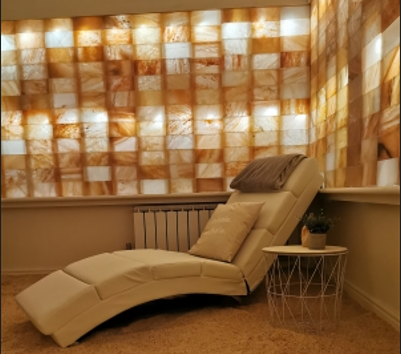In today’s post, we cover some of the most commonly asked questions about salt therapy.
What is salt therapy?
Salt therapy, also known as halotherapy, is a form of alternative medicine that involves breathing in salt-enriched air in order to improve respiratory and skin conditions. Salt therapy is based on the idea that breathing in salt-enriched air can provide health benefits, particularly for respiratory and skin conditions. The therapy is typically administered in a salt cave or a salt room, which are specially designed spaces that are lined with salt bricks or salt crystals.
A device called a halogenerator is used to crush and grind salt into microscopic particles, which are then dispersed into the air. The salt particles are believed to have anti-inflammatory and antibacterial properties, and can help to clear mucus and reduce inflammation in the lungs and airways.
Proponents of salt therapy claim that it can help to alleviate symptoms of conditions such as asthma, allergies, bronchitis, cystic fibrosis, and chronic obstructive pulmonary disease (COPD). It is also believed to improve skin conditions such as eczema and psoriasis, by providing a natural moisturizer and reducing inflammation.
The therapy is generally considered safe and non-invasive, and can be used alongside other treatments.
However, it is important to note that there is limited scientific evidence to support the effectiveness of salt therapy. While some studies have found that salt therapy may be beneficial for certain respiratory conditions, more research is needed to confirm these findings and to understand how salt therapy works. It’s always good to consult with a healthcare professional before trying any alternative therapy.
What is a halogenerator?
A halogenerator is a device that is used to grind salt into microscopic particles and disperse it into the air. It is a key component of salt therapy, also known as halotherapy. The device typically consists of a chamber in which salt is placed and a mechanism that grinds the salt into fine particles. The particles are then released into the air through a ventilation system, creating a salt-enriched microclimate.
Halogenerators come in different designs and sizes, and can be used in a variety of settings, such as salt caves, salt rooms, and even in some spas. Some halogenerators are designed for use in residential settings, and can be used to create a salt-enriched environment in a home or personal space.
It’s important to note that there is a difference between halogenerators and salt lamps. While both can release salt particles into the air, salt lamps simply release salt ions from the heat of a bulb and not through the grinding process.
What is a salt cave?
A salt cave is a type of underground chamber that is lined with salt bricks or salt crystals. It is typically used for salt therapy, also known as halotherapy. The cave is designed to create a microclimate that is rich in salt particles, which are believed to have anti-inflammatory and antibacterial properties.
Salt caves are typically dark, quiet and have a comfortable temperature. Visitors sit or recline in the cave and breathe in the salt-enriched air, which is believed to help clear mucus and reduce inflammation in the lungs and airways. Some salt caves also have ambient lighting and calming music.
Salt caves are often found in spas or wellness centres, but can also be found in some natural settings, such as underground salt mines.
What are the benefits of salt therapy and what conditions can it help to treat?
Proponents of salt therapy believe that the salt particles can help to clear mucus and reduce inflammation in the lungs and airways, as well as improve skin conditions such as eczema and psoriasis. Salt therapy is also believed to improve breathing, reduce stress and improve overall well-being.
Respiratory conditions: Salt therapy is believed to help alleviate symptoms of respiratory conditions such as asthma, allergies, bronchitis, cystic fibrosis, and chronic obstructive pulmonary disease (COPD) by helping to clear mucus and reduce inflammation in the lungs and airways. Salt therapy may also be beneficial for people with a chronic cough, sinusitis and other respiratory problems.
Skin conditions: Salt therapy is also believed to improve skin conditions such as eczema and psoriasis, by providing a natural moisturizer and reducing inflammation. Salt particles can help to remove impurities and dead skin cells, and promote circulation to the skin.
Stress reduction: Salt therapy is also believed to reduce stress and improve overall well-being. The peaceful and relaxing environment of the salt cave, combined with the natural healing properties of salt can help reduce stress and promote relaxation.
Disclaimer: The information provided in this blog post is for educational purposes only. It does not constitute medical advice. Always consult with a healthcare provider for personalized recommendations.


Recent Comments